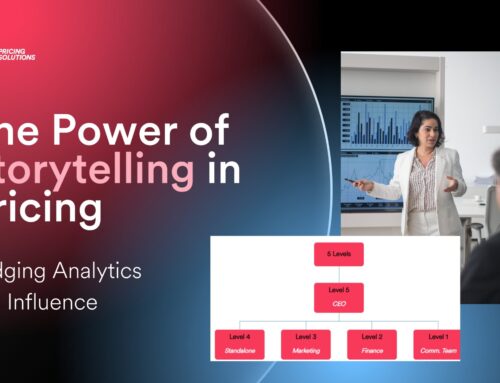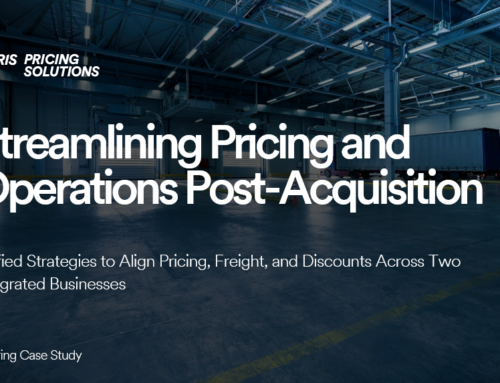Pricing is one of the most under looked aspect of a business’s’ operations. Yet pricing strategies are a key way for organizations to improve their bottom line. Research indicates that by properly managing pricing strategies a company can increase profitability by 25 to 60 percent. Unfortunately, many businesses overlook pricing and miss out on these potential profits.
Look past cost-plus pricing
Many pricing strategies stop at cost-plus pricing (the practice of setting prices based on material costs, labour costs and then applying a markup). What this method fails to do is capture the perceived value of a company’s products or services. By implementing a value-based pricing model, an organization can dramatically improve their profitability.
Focusing resources on re-strategizing your pricing scheme can yield great returns. In the case of some Pricing Solutions clients, we have seen that a one percent price increase can yield a 12.5 percent profit increase. We think that your business can achieve these results as well here are 5 ways to leverage your pricing to deliver more profitable results.
1. Develop a ‘1%’ pricing mindset
Pricing managers must not underestimate the importance of one-per-cent. Discounted prices of five to ten percent can dramatically affect profitability and can actually deter future customers. It is crucial that everyone in the company understands the gravity of every percent in pricing and fight for it. “It’s not about nickel-and-diming your customers”, says Paul Hunt, president of Pricing Solutions. “It’s about focusing on the value you deliver, so you don’t have to compromise on price.”
Take for example company X, which in its early days had the founder and CEO acting as the de facto pricing manager. As the organization grew, so did the CEO’s responsibilities. Consequently, the pricing responsibilities fell by the wayside. In the absence of a coordinated strategy, prices were all over the board — the finance department wanted prices to go up, sales wanted them to go down, and marketing was caught in the middle. As a result, profits suffered.
In reaction, the CEO reaffirmed the importance of developing a pricing policy, adjusting compensation, and assigning clear responsibility for pricing. These actions cemented the 1% pricing mindset. Leading the organization to achieve higher profits
2. Consistently deliver more value
The most successful organizations consistently deliver more value to their customers and are able to capture improved margins as a result. Best-practice-pricing strategies excel at the three key stages of value management:
Creation
During product-development organization’s must be rigorous in their pricing assumptions. Extreme attention must be targeted to understanding customer’s pricing sensitivities and to what they value. Avoid developing products with ‘bells and whistles’ that customers do not value and are unwilling to pay for. Compaq Computers, for example, implemented a ‘design to price strategy’ after realizing their traditional high-end market was disappearing. Compaq in response set a price-point of $2,000 and built the best computer they could for that price.
Communication
An organisation should sell on value not price. It is imperative that when you communicate with customers that you focus on how the products and services uniquely meet their needs. “To be able to do that effectively, you have to get inside your customer’s head. Getting close to your customer is the single most critical factor in value-based pricing,” says Hunt.
Delivery
The moment of truth is when the customer uses your product or service (delivery/aftersales stage). A satisfied customer is a profitable one. Customer satisfaction means clients value your firm’s offering, which leaves room for higher prices.
Each of these stages presents unique pricing challenges, but all centre on creating and delivering more value.
3. Price strategically, not opportunistically
Organizations must be cautious about pricing to price-conscious customers in an attempt to boost volume. This tactic will put your core business at risk by pursuing customers who don’t value the product or service but only the price. Companies must identify who their core customers are and keep the pricing integrity of that market.
A company specializing in storing and distributing high-end pharmaceutical products once contemplated selling its services to a more price-sensitive segment of the market. However, offering lower prices to non-core customers created the risk of alienating the company’s core customer base. Fortunately, before making this potentially disastrous decision, the company adjusted their pricing structure. It decided to reduce the level of service it would provide to the price sensitive segment. Enabling the company to still provide fair value to its core customers at higher prices while gaining new business.
4. Diplomacy with the competition
Diplomats avoid wars, generals fight them. No one wins in a pricing war, and the key to preventing one is by understanding the competition around your organization. Gathering and processing information about competitors is the foremost tool of a diplomat. This ensures that your pricing strategies are driven by knowledge rather than fear.
Information is pointless unless an organization as the systems in place to mine, manage, and disseminate it. For example, one company set up a toll-free telephone number for salespeople to report competitive information rather than writing reports. It also built an incentive program for the best tips of the month. The company built a culture that motivated salespeople to share their information and streamlined the process to consolidate knowledge. All of which gave the company an edge over their competition.
An organization can spend years building up value for its product or service, but if their pricing is not calibrated with competition, it can squander investments and miss out on profits. Competitive pricing is critical to value-based pricing
5. Pricing is a process
Pricing is not a single hyperbolic strategy, it is a continual process. Decisions cannot be implemented and then forgotten about.
In the absence of a solid pricing process, one major consulting firm reverted to ad hoc or ‘gut pricing. The result? “I’ve seen two people sell the same services and price them 100 percent differently,” says Hunt. “It’s because they don’t understand the value, don’t understand the customer, so they rely on their own perceptions of the world.” Active and coordinated pricing management is essential. This means establishing a pricing policy, using analytical tools, and training personnel.
Just because one strategy has been implemented successfully does not mean it will always be effective. Best-practice pricing is an involved process, where strategies must always be revisited and optimized.





